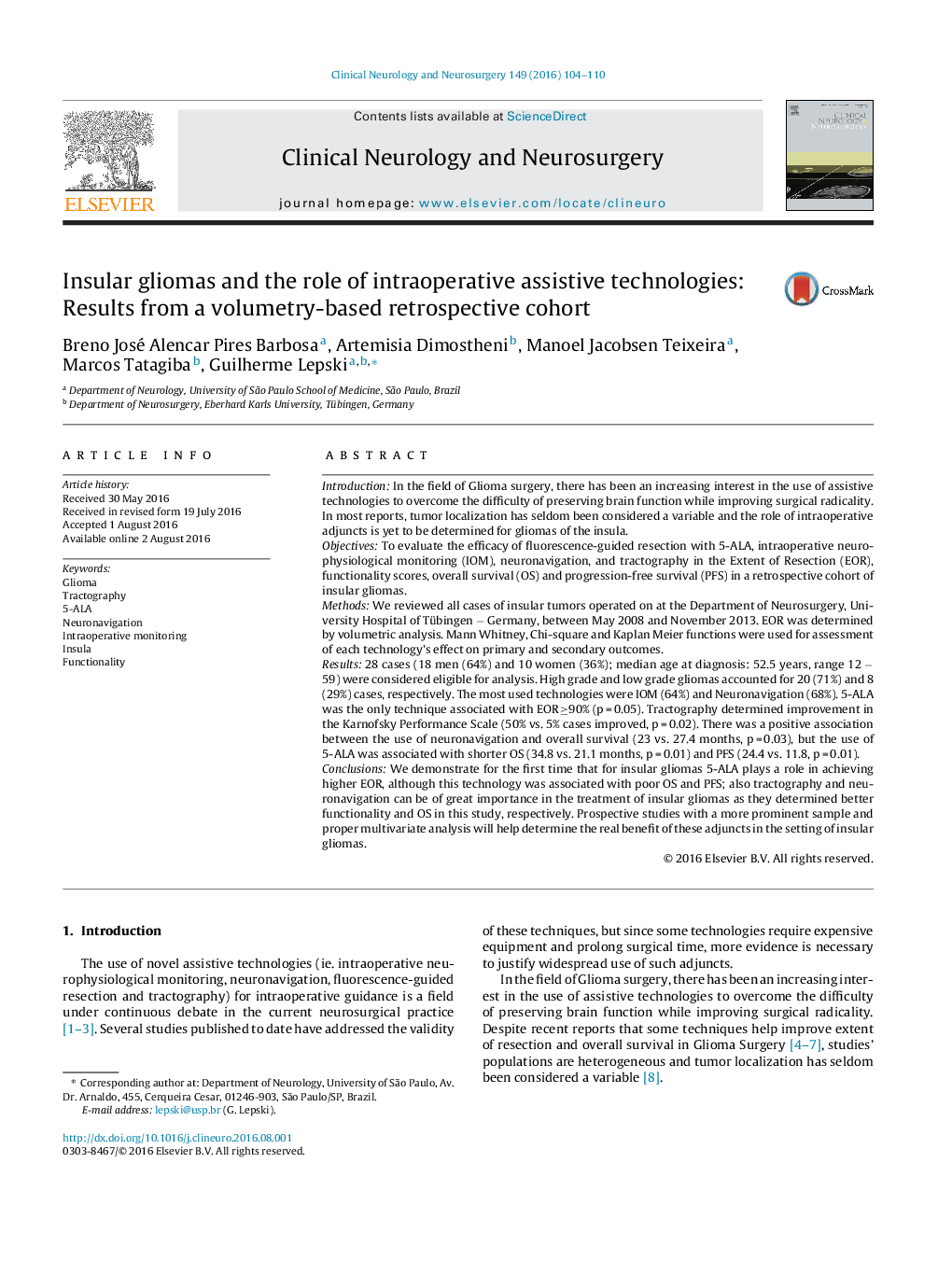| کد مقاله | کد نشریه | سال انتشار | مقاله انگلیسی | نسخه تمام متن |
|---|---|---|---|---|
| 3039465 | 1579673 | 2016 | 7 صفحه PDF | دانلود رایگان |
کلمات کلیدی
1.مقدمه
2. روش ها
2.1 انتخاب بیمار
2.2 تکنولوژی های یاری رسان
2.2.1 تراکتوگرافی
2.2.2 رهیابی عصبی
2.2.3 مانیتورینگ نوروفیزیولوژیکی حین عمل (IOM)
2.2.4 ریسکشن با هدایت فلورسانس 5-آمینولوولینیک اسید (5-ALA)
2.3 مراقبت های جراحی و ارزیابی بالینی
2.4 آنالیز حجم سنجی
2.5 آنالیز آماری
2.6 مسائل اخلاقی
3. نتایج
4. بحث
5. نتیجه گیری
• 5-ALA fluorescence was the only technique associated with EOR.
• 90%.
• The use of tractography determined improvement in the Karnofsky Performance Scale.
• The use of neuronavigation increased overall survival.
• 5-ALA fluorescence may worsen overall and progression-free survival.
IntroductionIn the field of Glioma surgery, there has been an increasing interest in the use of assistive technologies to overcome the difficulty of preserving brain function while improving surgical radicality. In most reports, tumor localization has seldom been considered a variable and the role of intraoperative adjuncts is yet to be determined for gliomas of the insula.ObjectivesTo evaluate the efficacy of fluorescence-guided resection with 5-ALA, intraoperative neurophysiological monitoring (IOM), neuronavigation, and tractography in the Extent of Resection (EOR), functionality scores, overall survival (OS) and progression-free survival (PFS) in a retrospective cohort of insular gliomas.MethodsWe reviewed all cases of insular tumors operated on at the Department of Neurosurgery, University Hospital of Tübingen − Germany, between May 2008 and November 2013. EOR was determined by volumetric analysis. Mann Whitney, Chi-square and Kaplan Meier functions were used for assessment of each technology’s effect on primary and secondary outcomes.Results28 cases (18 men (64%) and 10 women (36%); median age at diagnosis: 52.5 years, range 12 − 59) were considered eligible for analysis. High grade and low grade gliomas accounted for 20 (71%) and 8 (29%) cases, respectively. The most used technologies were IOM (64%) and Neuronavigation (68%). 5-ALA was the only technique associated with EOR ≥90% (p = 0.05). Tractography determined improvement in the Karnofsky Performance Scale (50% vs. 5% cases improved, p = 0.02). There was a positive association between the use of neuronavigation and overall survival (23 vs. 27.4 months, p = 0.03), but the use of 5-ALA was associated with shorter OS (34.8 vs. 21.1 months, p = 0.01) and PFS (24.4 vs. 11.8, p = 0.01).ConclusionsWe demonstrate for the first time that for insular gliomas 5-ALA plays a role in achieving higher EOR, although this technology was associated with poor OS and PFS; also tractography and neuronavigation can be of great importance in the treatment of insular gliomas as they determined better functionality and OS in this study, respectively. Prospective studies with a more prominent sample and proper multivariate analysis will help determine the real benefit of these adjuncts in the setting of insular gliomas.
Journal: Clinical Neurology and Neurosurgery - Volume 149, October 2016, Pages 104–110
